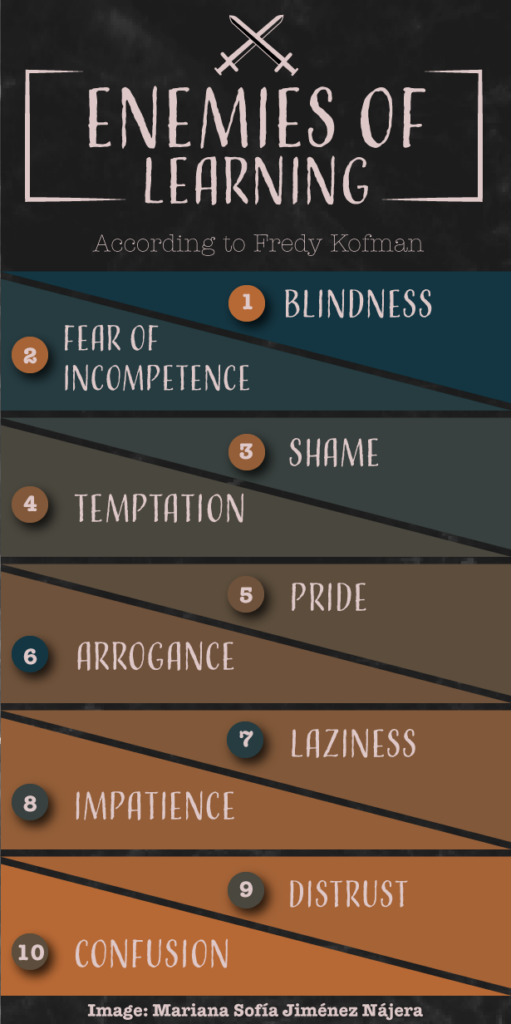Learning is not always a simple path, and although most of us consider ourselves its supporters, we minimize the strong enemies that threaten us during this process that consists of several stages. While external limitations exist, such as a lack of economic resources or a motor disability, internal enemies do not discriminate against anyone; we have all faced at least one or two in our lifetime.
Identifying these obstacles strengthens our defenses to complete a learning cycle and advance to the next adventure. Otherwise, not knowing how to identify our internal opponents allows them to block our understanding in the learning process.
The first enemy we have all endured, and from which perhaps all others derive, is fear. Since learning is hardly what we expect, we tend to regress when meddling with the unknown and want to return to the comfort of what we know. In the book Metamanagement, author Fredy Kofman proposes the ten most common enemies that any apprentice can face on their journey and sabotage their learning, from which fear is the root:

- Blindness: This first enemy refers to the fact that we are unaware of our incompetence. Since we don’t know that we don’t know, we think we have nothing more to learn, and we close ourselves to new knowledge. To overcome blindness, having an awareness of not knowing is fundamental.
- Fear of incompetence: Admitting that we are incompetent and don’t know something can be difficult for people’s self-esteem. In general, being afraid of incompetency translates into fear of breaking their image in front of others and themselves. They anticipate the results of the learning cycle and are scared to fail.
- Shame: Like an infant’s first steps (clumsy, unbalanced, and even funny), the acquisition of new knowledge is full of mistakes. However, an insecure person focuses on the shame of their flaws and runs away, humiliated. The key to coping with this feeling is to accept that not always being right is a natural part of the learning curve, and like babies taking their first steps, there is no option but to get up and keep trying until we get the desired results.
- Temptation: There is no easier way to get out of a problem than to victimize yourself. The temptation to become a victim is an easy way to blame external factors and detach yourself from the learning process.
- Pride: People who are victims of this enemy do not seek help from others, intending to show their independence; for them, asking for help is a sign of weakness. However, seeking help shows that you recognize a need that has to be addressed, which should not be perceived negatively. People should feel more competent and comfortable for wanting to increase their understanding with the help of teachers or colleagues.
- Arrogance: This opponent deceives us into thinking we already know everything. Humility is the key to putting this aside so we can see the areas of opportunity to improve and meet the previously established learning objectives. Admitting not knowing and being open to feedback are coping techniques for arrogance.
- Laziness: Practice makes perfect. Learning is an activity that requires continuous energy and effort, so a lazy person prefers to maintain their incompetency. Planning and discipline are the primary tools to defeat this enemy.
- Impatience: As mentioned above, the path of learning takes work. One must have long-term motivation and not depend on immediate gratification, which can frustrate the learner. Self-compassion must be practiced to cope with moments where what we have learned does not go well at first or when we cannot apply that knowledge instantly.
- Distrust: Trusting our teachers and oneself is vital because distrust creates a barrier that hinders and can make learning impossible. Submitting to the teacher’s teachings makes us more open to such knowledge. On the other hand, our minds fill with negativity by not having confidence in ourselves. If a person constantly thinks they won’t achieve their goal, they will be filled with so many negative thoughts that they won’t be able to do it.
- Confusion: Patience and trust are necessary because sometimes we do not understand why we need to learn a practice or exercise that doesn’t look related to the subject that is currently being learned. Unknown and new things are scary and can even make us angry, so confusion and lack of trust in the instructor can scare some people away. Being open and positive helps us have the motivation to learn what comes. We will understand the reason for that practice or exercise in the future.
The key to facing opponents is knowing who they are, being aware of them at all times, and planning strategies to cope and keep going. However, the most important thing is not to run away from them because despite being terrified, a person can move forward with their learning. Over time, fear will retreat, replaced by positive feelings such as high self-esteem and determination, driving the person to achieve their mission and advance towards new learning.
Can you recognize the enemies that sabotage your learning process? Are you ready to face them?
Source: Kofman, F. (2001) Metamanagement Volume I. Naucalpan, Mexico: Ediciones Granica México S.A. de C.V.
Translation by Daniel Wetta
This article from Observatory of the Institute for the Future of Education may be shared under the terms of the license CC BY-NC-SA 4.0 
)
)


)